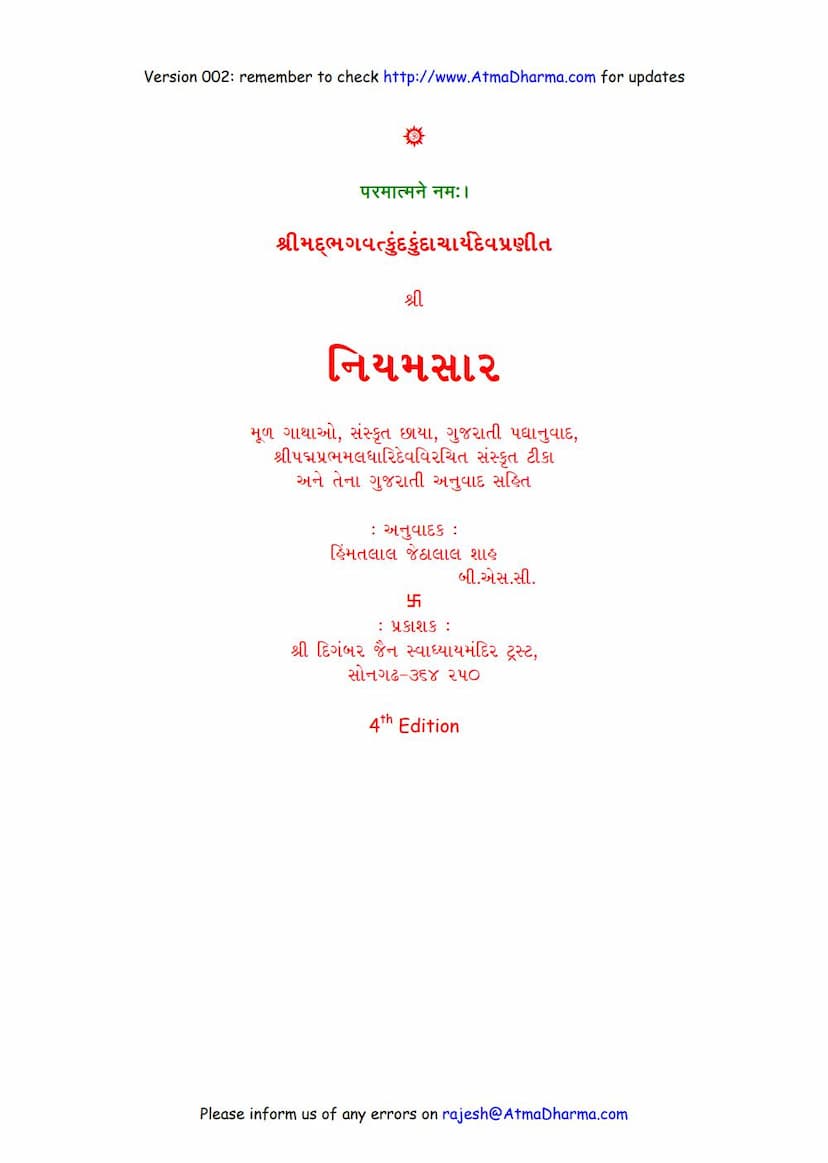Niyamsara
Added to library: September 2, 2025

Summary
Based on the provided text, here's a comprehensive summary of the Niyamsara in English:
Niyamsara: The Essence of the Rule
The Niyamsara is a fundamental Jain scripture authored by Acharya Kundkundacharya, with a Sanskrit commentary by Padmprabhacharya. Published by Shree Digambar Jain Swadhyay Mandir Trust, it is considered the third of Kundkundacharya's major works after Samaysara and Pravachanasara. This text delves deeply into the core principles of the Jain path to liberation, emphasizing the importance of adherence to true spiritual principles or "rules."
Core Teachings and Structure:
The Niyamsara is a profound spiritual discourse that aims to guide the aspirant (mumukshu) towards the realization of the true nature of the soul, the Parmatma Tattva (Supreme Soul essence). The central theme revolves around the "rule" or "essence" (niyam) that leads to liberation (moksha). This essence is ultimately identified with the Ratnatraya (the three jewels of right faith, right knowledge, and right conduct) in their purest, most fundamental form.
Key Concepts:
-
Parmatma Tattva (The Supreme Soul): The text strongly emphasizes the soul's inherent nature as pure, eternal, and blissful consciousness. It is the ultimate reality that lies beyond all worldly possessions, conditions, and imperfections. The soul, in its true essence, is the source of supreme happiness.
-
The Path to Liberation (Moksha Marga): The Niyamsara elaborates on the path to liberation as the exclusive means to attain true happiness. This path is not about external rituals or the accumulation of merit, but rather the inward journey of self-realization.
-
Rejection of Externalities: A significant theme is the absolute need to detach from all external phenomena, including the body, senses, worldly pleasures, and even the conventional practices of religious life when they are not rooted in true self-knowledge. The text distinguishes between true spiritual practice and mere external observance.
-
The Importance of Right Faith, Knowledge, and Conduct (Ratnatraya): The Niyamsara highlights that the soul's liberation is achieved through the unwavering practice of the three jewels:
- Samyagdarshan (Right Faith): Unwavering faith in the true nature of the soul and the Jain principles, free from doubts, delusions, and misconceptions.
- Samyagjnana (Right Knowledge): Accurate and thorough knowledge of the soul and the nature of reality, distinguishing the self from non-self.
- Samyakcharitra (Right Conduct): The manifestation of right faith and right knowledge in one's actions, thoughts, and speech, leading to the eradication of passions and the realization of the soul's inherent purity.
-
The Nature of True Practices: The text emphasizes that true practices like pratikramana (self-reflection and repentance for past transgressions), pratyakhyana (vows of abstaining from certain actions), samayika (equanimity), tapa (asceticism), and dhyana (meditation) are not mere external actions but rather the inward spiritual disciplines that purify the soul. True pratikramana, for example, is not just outward confession but the eradication of inner passions.
-
The Role of Nayas (Perspectives): Like other Kundkundacharya texts, Niyamsara often employs the Nayas (viewpoints or perspectives), primarily Nischaya Naya (the ultimate, absolute truth) and Vyavahara Naya (the conventional or practical truth), to explain complex spiritual concepts. The ultimate goal is to transcend all duality and realize the Nischaya Naya perspective of the soul's pure nature.
-
The Soul as the Ultimate Refuge: The Niyamsara constantly directs the reader back to the soul (atma) as the sole refuge and the ultimate source of all bliss. All external practices, even those appearing virtuous, are ultimately considered means to an end – to facilitate the inward focus on the soul.
Key Sections (Adhikaras):
The Niyamsara is typically divided into several chapters or sections (adhikaras), which systematically explore the path:
- Jiva Adhikara: Deals with the nature of the soul.
- Ajiva Adhikara: Discusses non-living substances.
- Shuddha Bhava Adhikara: Explains pure spiritual states.
- Vyavahara Charitra Adhikara: Focuses on conventional conduct.
- Nischaya Pratikramana Adhikara: Delves into the ultimate practice of self-reflection.
- Nischaya Pratyakhyana Adhikara: Explains the true meaning of renunciation.
- Nischaya Prayashchitta Adhikara: Discusses the ultimate repentance.
- Nischaya Samayika Adhikara: Explains true equanimity.
- Nischaya Paramavashyaka Adhikara: Discusses the essential self-practice.
- Shuddha Upayoga Adhikara: Focuses on pure spiritual consciousness.
Significance:
The Niyamsara is highly revered in the Digambar Jain tradition for its clear and profound exposition of the path to liberation. It provides practical guidance on how to live according to Jain principles, emphasizing the internal transformation of the soul over external rituals. Acharya Kundkund's teachings in Niyamsara continue to be a guiding light for spiritual seekers aiming for self-realization and ultimate freedom.